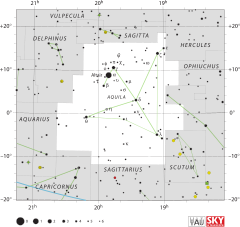| Observation data Epoch J2000 Equinox J2000 | |
|---|---|
| Constellation | Aquila |
| Right ascension | 19h 34m 05.3529s[1] |
| Declination | +07° 22′ 44.189″[1] |
| Apparent magnitude (V) | 4.45[2] |
| Characteristics | |
| Spectral type | K3-IIIb Fe0.5[3] |
| U−B color index | +1.24[2] |
| B−V color index | +1.176[4] |
| R−I color index | 0.61 |
| Astrometry | |
| Radial velocity (Rv) | −24.73±0.13[5] km/s |
| Proper motion (μ) | RA: +213.73[1] mas/yr Dec.: −156.55[1] mas/yr |
| Parallax (π) | 30.31 ± 0.24 mas[1] |
| Distance | 107.6 ± 0.9 ly (33.0 ± 0.3 pc) |
| Absolute magnitude (MV) | 1.80[5] |
| Details[6] | |
| Mass | 1.16±0.10 M☉ |
| Radius | 7.43±0.15[7] R☉ |
| Luminosity | 24.5 L☉ |
| Surface gravity (log g) | 2.70±0.06 cgs |
| Temperature | 4,567±79 K |
| Metallicity [Fe/H] | 0.16 dex |
| Rotational velocity (v sin i) | 0.0[4] km/s |
| Age | 6.71±2.19 Gyr |
| Other designations | |
| Database references | |
| SIMBAD | data |
Mu Aquilae, Latinized from μ Aquilae, is the Bayer designation for a single[9] star in the equatorial constellation of Aquila. With an apparent visual magnitude of 4.45,[2] it is visible to the naked eye. The measured annual parallax shift of this star is 30.31 mas,[1] which gives a distance estimate of 107.6 light-years (33.0 parsecs) from Earth. It is drifting closer with a radial velocity of −25 km/s,[5] and displays a relatively high proper motion, traversing the celestial sphere at the rate of 0.264″ per year.[10]
The stellar classification of Mu Aquilae is K3-IIIb Fe0.5,[3] indicating that this is an evolved giant star with a mild overabundance of iron appearing in its spectrum. It belongs to a sub-category of giants called the red clump, which means it is generating energy through the fusion of helium at its core.[11] Compared to the Sun, it has 116% of the mass and has expanded to 7.7 times the size. This inflated outer envelope has an effective temperature of 4,567 K and is radiating 24.5 times the Sun's luminosity.[6] At this heat, Mu Aquilae glows with the orange hue of a K-type star.[12] It is roughly seven billion years old.[6]
- ^ a b c d e f Cite error: The named reference
aaa474_2_653was invoked but never defined (see the help page). - ^ a b c Cite error: The named reference
clpl4_99was invoked but never defined (see the help page). - ^ a b Cite error: The named reference
Keenan_McNeil_1989was invoked but never defined (see the help page). - ^ a b Cite error: The named reference
aj135_1_209was invoked but never defined (see the help page). - ^ a b c Cite error: The named reference
aaa454_3_943was invoked but never defined (see the help page). - ^ a b c Cite error: The named reference
Villaver_et_al_2013was invoked but never defined (see the help page). - ^ Cite error: The named reference
Baines2023was invoked but never defined (see the help page). - ^ Cite error: The named reference
SIMBADwas invoked but never defined (see the help page). - ^ Cite error: The named reference
Eggleton_Tokovinin_2008was invoked but never defined (see the help page). - ^ Cite error: The named reference
Lepine_Shara_2005was invoked but never defined (see the help page). - ^ Cite error: The named reference
apj539_2_732was invoked but never defined (see the help page). - ^ Cite error: The named reference
csirowas invoked but never defined (see the help page).
